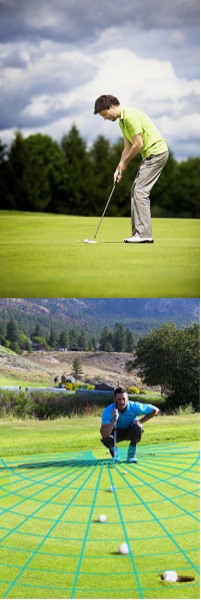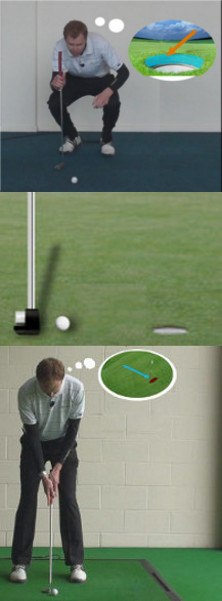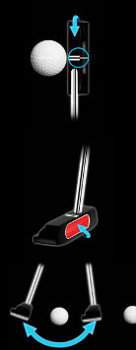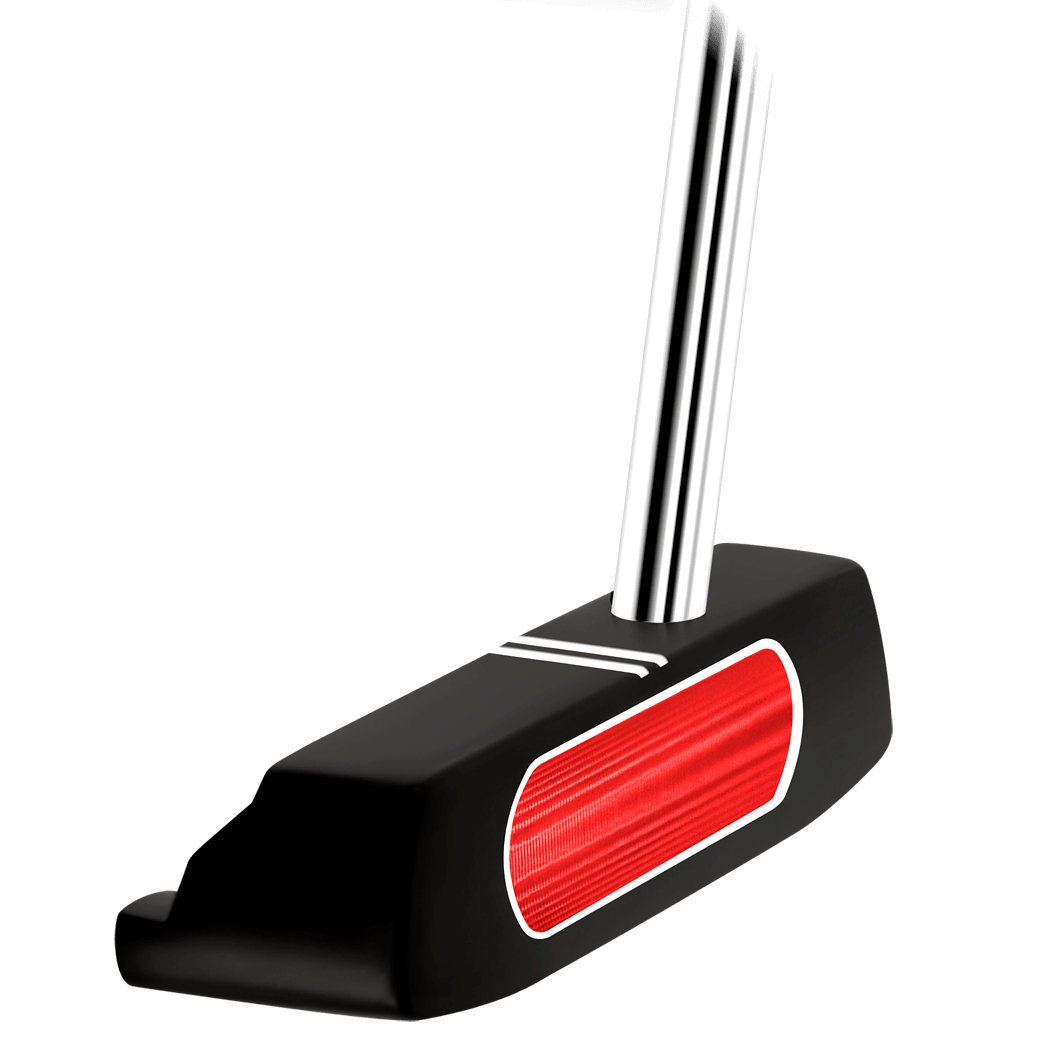
Putting is by far the most overlooked part of most amateur's golf game but is so crucial to a golfer having the complete package.
It is important to start the game off right by spending some time understanding and developing a solid stroke. Not all golfers spend time practicing their game off the course and when they do it typically involves them hitting their driver as hard as they can at the driving range. Hitting the driver really far is a lot of fun to do and watch, but it isn't going to help you get your game where you ultimately want it to be.
When you think about it, putting is nearly half the game as roughly 40% of the strokes that you take during a round will be with your putter. This is why it's so important to practice your putting as much as you can. The great thing is that most golf courses have a putting green where you can freely practice putting before you take your leave for the course.
The set up for putting is substantially different than that off a full golf swing. When putting, you'll want to have a much narrower stance than you would have with your full golf shot. The narrower stance is fine since you don't need all the hip and shoulder turn that gives your full swing all of its power. In fact, you really want your body to stay fairly still.
Before you hit a putt, you'll want to look at the line between your ball and the hole to see what you think the ball is going to do. Sometimes you'll want to look from behind the hole to your ball. This allows you to see how the ball will move during the putt, due to undulations in the green.
A good way to set up to the ball is to grip your putter and extend your arms out straight in front of your body. You'll then want to bring the elbows into your body. Bend over at the hips so that your club is now touching the ground, and your eyes are directly over the golf ball. Having your eyes directly over the golf ball will help you see the line on which you want to send your putt.
During your putting stroke, your shoulders, arms, hands and the putter need to act as one solid unit. You will use your shoulders to determine how big your swing is and how far you want the ball to roll. A good putting stroke is often compared to a pendulum like motion. Your putting stroke should have a smooth and even tempo from start to finish.
If you're having problems with putting then feel free to experiment with your own fixes and cures. Putting is very individualistic and if you are a creative person then test out many different methods until you find one that works consistently. There is not necessarily one correct way to putt but the more you practice and experiment intelligently, the more you will learn, improve, and enjoy the game.

Beginner Golf Tip: How to Putt
When first getting started in golf, it is tempting to head straight for the driving range to learn how to swing the club. After all, learning how to hit full shots is a tremendous challenge, and you are only going to improve with experience. However, as any experienced golfer will tell you, there is a lot more to playing this game than just hitting the ball straight. Specifically, you need to be able to putt if you are going to make progress toward lower scores. Putting is incredibly important in golf, and that applies for everyone from a total beginner on up to an accomplished pro.
Fortunately, putting is considerably less complicated than hitting full shots. There are a number of mechanics and fundamentals involved in the full swing, but the putting stroke is far simpler. That is not to say that it is easy, of course, as many experienced golfers still struggle on the greens. However, for the beginning golfer hoping to make some progress, putting is a great place to start because of its relative simplicity. Once you learn the basics, you can head out onto the practice putting green and roll the ball toward the cup over and over again. By starting out with a focus on putting, you could set yourself up for many years of solid performance with the flat stick – even if your full swing doesn't perform at quite the same level.
In this article, we are going to cover a number of topics related to putting. These topics will be particularly helpful to the beginning golfer, but even an experienced player may be able to pick out one or two tips that could help them hole more putts. To putt well, you have to bring together a number of different elements, including solid mechanics, a good plan, the right equipment, and more. When you are done with this article, you should have a clear understanding of the big picture in the world of putting.
In addition to its importance in the game, there is another reason why putting practice is great for amateur golfers – it is usually free. Most courses will allow you to use their practice green free of charge, so you don't have to break your budget just to work on your game. Golf has never been known as an affordable sport, so any little bit of savings can help. Of course, you should help support the facility that you frequent for practice purposes, so consider buying some of your gear from their pro shop, or at least pick up a snack from their restaurant from time to time. It is expensive to maintain a golf course in nice condition, and your business will go a long way toward helping the course make ends meet month after month.
All of the content below is based on a right-handed golfer. If you happen to play left-handed, please take a moment to reverse the directions as necessary.

The Physical Basics
In this section, we are going to outline the basics of proper putting technique. For an experienced player, these points will certainly be review. For a beginner, however, they may be new information. If you are just getting started in the game, use the following tips to direct your practice when you head out to the putting green for the first time.
- Keep your eyes on the ball. This is a clichéd golf tip, but it is just as important now as it was years ago. You need to watch the ball as you make your putting stroke, because it is always easier to hit something if you can see it. Pick out a spot on the top of your ball and watch that spot until the ball has rolled away. In addition to the importance of being able to see the ball, keeping your eyes still also helps because it should promote stillness in the rest of your body as well. There are very few moving parts in a proper putting stroke, so keeping your eyes trained on the ball is a good first step toward solid technique.
- Make a compact stroke. You don't want to make a long swing when hitting most of your putts. Unless you are facing a tremendously long putt, you likely will be able to reach the hole with just a small, controlled motion. It is easy to lose control of your stroke when you let it get too long, so avoid falling into that trap. As a good rule of thumb, you should try to make your backstroke and your forward stroke roughly the same length. As you gain experience on the practice green, you will start to get a feel for how much stroke is necessary to propel the ball the appropriate distance.
- Use light grip pressure. One of the most common mistakes made by beginning golfers when learning to putt is holding on to the grip too tightly. You need to have a great feel for the club while putting, which means you want to avoid placing too much pressure in your fingers. Do your best to relax while getting ready to putt, making sure your fingers are relatively loose around the handle. You need to hold on just tight enough to control the club, and no tighter. As you practice, experiment with various grip pressures until you find a comfortable balance between control and freedom.
- Bend your knees. It is easy to take the lower body for granted when putting. That would be a mistake, however, as you need a stable base on which to build your stroke. As you address the ball, bend your knees and keep them bent throughout the stroke and into the finish. You don't have to bend them significantly – but it is important to have at least some degree of bend to keep your lower body engaged. To make sure your body is doing a good job of staying still during the stroke, pay attention to the position of your kneecaps from start to finish. If they don't move, it is a good bet that the rest of your body is holding still as well.
- Accelerate through impact. The club should be accelerating throughout the forward stroke, at least until the ball is gone. By picking up speed as you make contact, you will create a sharp strike that is more likely to send the ball on the proper line. Many amateur golfers go wrong on this point, unfortunately. Those players make a long back stroke, decelerate on the way through to prevent the ball from going too far, and miss their line as a result. Don't put yourself in that category. Make a compact backstroke so you can freely accelerate on the way through.
Each of the five points listed above should be relatively easy to implement on its own. When you add them up, however, you start to face a bigger challenge. Work on one point at a time on the practice green until you start to feel comfortable with your evolving stroke. Before long, you should find that all five of these fundamentals are included in your technique.

The Mental Basics
Putting is not only a physical challenge, but a mental one as well. In fact, it could be argued that the mental side of this equation is even more important than the physical mechanics which make up your stroke. After all, it is not particularly difficult to move the putter a few inches in either direction on a short putt – but it is difficult to keep your brain out of the way while trying to knock the ball in the hole.
In this section, we are going to specifically address the basics of getting into the right mindset on the greens. With your mind in the right place, that technique you developed in the previous section will be free to shine through.
- Use careful speed. Some players, both beginners and experienced golfers, try to ram the ball into the back of the cup by hitting their putts with aggressive speed. Generally speaking, this is a bad idea. While this strategy can look great when it works, it is more likely to go wrong. Should you miss the hole, your hard-charging putt is going to race several feet past the hole – meaning you will have a tough follow-up putt to finish the hole. There is nothing that will ruin your score faster than three putting, so try to use careful speed in order to bring the ball to rest right next to the cup. With good speed, you will give yourself a chance to have the ball fall in without having to worry about the next one should you miss.
- Play more break than you think. In the golf world, the low side of the hole is commonly referred to as the 'amateur side'. Why is that the case? Simple – most amateur golfers miss their putts on the low side. This is the result of not playing enough break when selecting a target line. On a sloping green, the ball is usually going to break more than you think – so pick a line that give your ball plenty of room to work back toward the cup. A putt which is traveling on the high side always has a chance to fall in, while a putt that has drifted low will miss every single time. Give yourself a chance and play a little more break than you think you should. This is a great strategy to pair with the previous point on using careful speed. When you roll the ball gently toward the hole, it will break more as it rolls than a putt which has been struck with more power. By hitting soft putts on a high line, you can drop the ball in over the top edge with incredible consistency.
- Take your time. The matter of pace of play is a touchy subject in golf. While golf is supposed to be a leisurely game where you are able to take your time as you make your way around the course, no one wants their 18-hole round to drag on for six hours. As a beginner, you are going to be especially aware of this topic, as you might feel as though you are holding up other, more experienced players. With all of that said, you do need to take your time when preparing to hit a putt. You need to get a good read for the slope of the green, and you need to decide on how much speed to give the putt. To make sure you don't hold up others as you play, be sure to walk with a good pace and avoid too much conversation unless you have a chance to chat while waiting for others to play.
- Try to make the putt. You might read this tip and think that it is a pretty silly thing to say. This is a critical point, however, once you understand it in the right context. Rather than trying to make their putts, most golfers try not to miss. There is an important difference in those two approaches. If you are trying not to miss, you will be putting tentatively. You will struggle to accelerate through impact, and you will be looking for ways to fail. Shift your way of thinking away from failure and instead look for ways to make the ball fall in. By thinking about making your putts rather than being worried about missing, your results should improve.
It is crucial to have the right mindset when you step foot on the putting green. You need to understand what you are trying to do with your putts so your body can take over and execute the stroke necessary to be successful. Too many golfers just wander up and knock the ball in the general direction of the hole – a strategy which is destined to fail. Take the tips above to heart and prepare your mind for great putting during your next round.

Putting Practice Tips
Knowing how to practice is a big part of the equation on this topic. If you practice the right things, you will be well-prepared to perform at a high level on the course. On the other hand, if you waste time practicing things which aren't really going to come in handy during your rounds, you will have missed out on a great chance to improve. Review the practice tips below and use these points to plan out your next putting practice session.
- Use one ball. It is tempting to drop several balls on the putting green when setting up for some practice. However, you will find that your results are significantly better when you use just one ball at a time. Why? Putting with only one ball is going to more accurately reflect the situation you will face on the course. You are not going to be putting from the same spot several time in a row during a round, so why do it in practice? Instead, putt just one ball and give your full attention to each of those putts. In the end, you might hit a few less putts with this method, but the putts you do hit will be much more meaningful.
- Spend plenty of time practicing short putts. Many golfers take their short putts for granted. Once you get inside three feet or so, you might assume that the next putt will be no problem at all – but nothing could be further from the truth. In reality, short putts are one of the great challenges that golf has to offer. If you are going to make progress with your game moving forward, you need to know how to knock in your short putts with confidence. As you work on making short putts, focus on keeping your head perfectly still while making a compact stroke. By keeping your stroke short and your head still, you will find that you can make most of these both in practice and on the course.
- Don't forget lag putts. You might think that you only need to practice putts which you have a chance to make. That is not the case. You also need to work on rolling the ball long distances across the green. Some of the most important putts you will hit during any round of golf are the lag putts. When you face a putt of considerable distance, you are focused only on getting down in two. By practicing the ability to control your speed over long distance, you will have a better chance of avoiding three putt greens on the course. While practicing lag putts, be sure to pick a quiet area of the practice green as to avoid getting in the way of other golfers.
It is important to practice your putting the right way. You only have limited practice time available, so making the most of that time is essential. Take the tips above and develop a practice routine you can use during each visit you make to the golf course.

Finding the Right Putter
Up until this point, we have covered the techniques – both mental and physical - that you are going to need to use in order to find success on the greens. While your techniques are going to make up most of the picture when it comes to putting, there is an equipment element at play here as well. You will need to have the right putter in your hands if you want to see the ball fall in more often than not.
Do you need to run out and purchase the most expensive putter on the market in order to play well? Absolutely not. You do, however, need to make sure that your putter hits on a few basic points. Those points are listed below.
- The correct length. When you take your stance, your putter should feel as though it falls into your hands naturally. If you are having to bend over an uncomfortable amount at address, or if you are having to stand too tall, you need to find a putter that is a different length. Your putter should be just long enough to where the end of the grips matches up nicely with your hands at address. Most players will be comfortable with a putter of either 34'' or 35'', but some players need to go up or down from those points depending on their body type.
- In good condition. While it isn't necessary to buy a putter which costs hundreds of dollars, you don't want to use something that you pulled out of the back of your garage either. If your putter is not in good condition, it may not perform as you expect time after time. Do yourself a favor – pick up a putter which is in good shape, and then care for it to make sure it remains in good condition for years to come. A good putter can actually last you a lifetime on the links, as long as it is cared for the right way.
- The right feel. Putting, more than any other part of the game, is about feel. That means you need to feel comfortable with the club in your hands while on the green. Does your current putter give you confidence as you prepare to make your stroke? If not, it is time for a change. Once you find a putter that does fill you with confidence, stick with it for as long as possible.
There is a lot to learn for the beginning golfer. This is a complicated game, and you aren't going to master it after just a few trips to the range. Rather than spending all of your time hitting full shots, be sure to visit the putting green for some short game work as well. You will progress more quickly if you are willing to work on all parts of your game. We hope the putting advice included above has been helpful – good luck!







